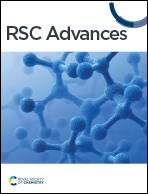Sulfamic acid grafted to cross-linked chitosan by dendritic units: a bio-based, highly efficient and heterogeneous organocatalyst for green synthesis of 2,3-dihydroquinazoline derivatives†
Abstract
In this work, novel cross-linked chitosan by the G1 dendrimer from condensation of melamine and toluene-2,4-diisocyante terminated by sulfamic acid groups (CS-TDI-Me-TDI-NHSO3H), as a bio-based and heterogeneous acidic organocatalyst, was designed and prepared. Also, the structure of the prepared organocatalyst was characterized by Fourier transform infrared spectroscopy (FT-IR), field emission scanning electron microscopy (FESEM), energy-dispersive X-ray spectroscopy (EDS), X-ray diffraction (XRD) and thermogravimetric analysis/derivative thermogravimetry (TGA/DTA). Subsequently, the catalytic performance of the biobased and dendritic CS-TDI-Me-TDI-NHSO3H, as a multifunctional solid acid, was evaluated for the preparation of 2,3-dihydroquinazoline derivatives through a three-component reaction by following green chemistry principles. Some of the advantages of this new protocol include high to excellent yields and short reaction times as well as easy preparation and remarkable catalyst stability of the introduced acidic organocatalyst. The CS-TDI-Me-TDI-SO3H catalyst can be used for up to five cycles for the preparation of quinazoline derivatives with a slight decrease in its catalytic activity.



 Please wait while we load your content...
Please wait while we load your content...